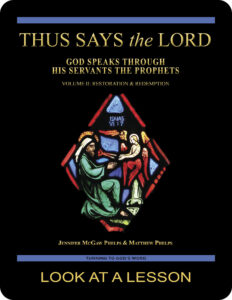 Thus Says the LORD: God Speaks
Thus Says the LORD: God Speaks
Through His Servants the Prophets
Volume II: Restoration & Redemption
Lesson 1 How the Divided Kingdom Came to an End
the Second Book of the Kings 17:1–41
the Second Book of the Kings 24:8—25:15
the Second Book of the Kings 25:18–21
Revised Standard Version Catholic Edition (RSVCE)*
New American Bible Revised Edition (NABRE)*
Catechism of the Catholic Church
ex libris (in our library)
Aperuit Illis (Instituting the Sunday of the Word of God)
Tami Palladino’s visual-meditation journal
glossary for Thus Says the LORD—Volume II
cross references in Thus Says the LORD—Volume II
next lesson: Jeremiah After the Fall of Jerusalem
This material coordinates with Lesson 1 on pages 4–13 in Thus Says the LORD: God Speaks Through His Servants the Prophets—Volume II: Restoration & Redemption.
“For as the rain and the snow come down from heaven,
and return not thither but water the earth, making it bring forth and sprout,
giving seed to the sower and bread to the eater,
so shall my word be that goes forth from my mouth;
it shall not return to me empty, but it shall accomplish that which I purpose,
and prosper in the thing for which I sent it.”
—the Book of Isaiah 55:10–11 (RSVCE)**
welcome to Volume II of our in-depth study of the biblical prophets
We invite you to check out the sample first lesson and video from Volume II of this Turning to  God’s Word
God’s Word  two-part Catholic Bible study. Our online pages link to the free related lesson videos, a glossary, and cross references in the biblical text, and include maps, additional commentary, and prayers based on the primary Scripture in each lesson. Thus Says the LORD: God Speaks Through His Servants the Prophets—Volume II: Restoration & Redemption contains 23 lessons and has been granted an imprimatur. It may be purchased from our website shop. The companion 28-lesson Volume I: A Kingdom Divided also is available for purchase. If you have a Bible-study question or comment, click on the “ask us your question” or “what do you think” button on any study page.
two-part Catholic Bible study. Our online pages link to the free related lesson videos, a glossary, and cross references in the biblical text, and include maps, additional commentary, and prayers based on the primary Scripture in each lesson. Thus Says the LORD: God Speaks Through His Servants the Prophets—Volume II: Restoration & Redemption contains 23 lessons and has been granted an imprimatur. It may be purchased from our website shop. The companion 28-lesson Volume I: A Kingdom Divided also is available for purchase. If you have a Bible-study question or comment, click on the “ask us your question” or “what do you think” button on any study page.
every Turning to God’s Word Bible study carries an imprimatur
 Thus Says the LORD: God Speaks Through His Servants the Prophets—Volume II: Restoration & Redemption
Thus Says the LORD: God Speaks Through His Servants the Prophets—Volume II: Restoration & Redemption  was granted an imprimatur by the Most Reverend William M. Joensen, Ph.D. (left), bishop of the Diocese of Des Moines, on June 11, 2021; the censor librorum for the Diocese of Des Moines, the Very Reverend Aquinas Nichols, granted the nihil obstat. These are official declarations that a book or pamphlet is free of doctrinal or
was granted an imprimatur by the Most Reverend William M. Joensen, Ph.D. (left), bishop of the Diocese of Des Moines, on June 11, 2021; the censor librorum for the Diocese of Des Moines, the Very Reverend Aquinas Nichols, granted the nihil obstat. These are official declarations that a book or pamphlet is free of doctrinal or 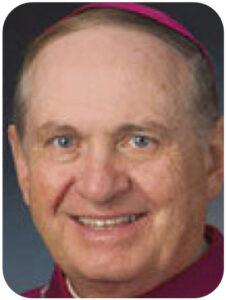 moral error. There’s no implication that those who’ve granted the imprimatur and nihil obstat agree with the contents, opinions, or statements expressed in the work. Turning to God’s Word Catholic Bible studies written before 2020 are being submitted to the Most Reverend Richard E. Pates (right), bishop emeritus of the Diocese of Des Moines. The first volume of this Catholic Bible study, Thus Says the LORD: God Speaks Through His Servants the Prophets—Volume I: A Kingdom Divided, was granted an imprimatur by Bishop Pates on July 9, 2018.
moral error. There’s no implication that those who’ve granted the imprimatur and nihil obstat agree with the contents, opinions, or statements expressed in the work. Turning to God’s Word Catholic Bible studies written before 2020 are being submitted to the Most Reverend Richard E. Pates (right), bishop emeritus of the Diocese of Des Moines. The first volume of this Catholic Bible study, Thus Says the LORD: God Speaks Through His Servants the Prophets—Volume I: A Kingdom Divided, was granted an imprimatur by Bishop Pates on July 9, 2018.
the popes inspire us—serious Catholics study the Word of God
In his apostolic letter Aperuit Illis (Instituting the Sunday of the Word of God) issued motu proprio (of his  own accord), Pope Francis established the Third Sunday in Ordinary Time to be devoted to the celebration, study, and dissemination of the Word of God. The Holy Father’s apostolic letter was published on September 30, 2019, the feast of St. Jerome and the 1600th anniversary of the saint’s death. St. Jerome, who translated the Latin
own accord), Pope Francis established the Third Sunday in Ordinary Time to be devoted to the celebration, study, and dissemination of the Word of God. The Holy Father’s apostolic letter was published on September 30, 2019, the feast of St. Jerome and the 1600th anniversary of the saint’s death. St. Jerome, who translated the Latin 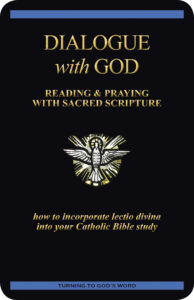 Vulgate Bible from Greek and Hebrew manuscripts, is famous for saying: “Ignorance of Scripture is ignorance of Christ,” and he’s the patron of translators and librarians. In Aperuit Illis, the Holy Father calls attention to the sacramental nature of the Word of God, pointing to the unbreakable bond between Sacred Scripture and the Eucharist. In 2025, the Church will celebrate the Word of God on Sunday, January 26. We’ve posted a free digital version of Dialogue with God: Reading & Praying with Sacred Scripture, our guide to incorporating the Church’s traditional practice of lectio divina (sacred reading) into regular Bible study.
Vulgate Bible from Greek and Hebrew manuscripts, is famous for saying: “Ignorance of Scripture is ignorance of Christ,” and he’s the patron of translators and librarians. In Aperuit Illis, the Holy Father calls attention to the sacramental nature of the Word of God, pointing to the unbreakable bond between Sacred Scripture and the Eucharist. In 2025, the Church will celebrate the Word of God on Sunday, January 26. We’ve posted a free digital version of Dialogue with God: Reading & Praying with Sacred Scripture, our guide to incorporating the Church’s traditional practice of lectio divina (sacred reading) into regular Bible study.
read more Church documents
Find links to magisterial documents referred to in Turning to God’s Word Catholic Bible  studies, including Aperuit Illis (Instituting the Sunday of the Word of God), at ex libris—magisterial documents. The page lists significant recent encyclicals as well as a number of historical Church documents.
studies, including Aperuit Illis (Instituting the Sunday of the Word of God), at ex libris—magisterial documents. The page lists significant recent encyclicals as well as a number of historical Church documents.
a few reminders about Turning to God’s Word Bible studies
The most distinguishing feature of our Bible studies is that they’re Catholic. Each one has been granted an imprimatur, which means that a bishop has read the work and found nothing contrary to Church teaching on morals or faith. Note that the imprimatur makes no claim that a work is equivalent to Church teaching, simply that it isn’t opposed to what the Church teaches. Practically speaking, this means that you don’t have to accept Turning to God’s Word interpretations of Scripture, only that choosing to do so doesn’t amount to heresy. Choosing not to accept conclusions of a work that has been granted an imprimatur doesn’t immediately plunge you into heretical territory, but choosing not to accept Church teaching related to those conclusions does.
read the Catechism—how to avoid heresy
The imprimatur reinforces and validates the claim that Turning to God’s Word Bible studies are Catholic. All participants have a right to expect that discussions about our Bible studies will focus on Catholic teaching. That doesn’t mean that someone won’t occasionally have a question about Church teaching. Not knowing what the Church teaches about a particular issue isn’t heretical. Asking a question about Church teaching isn’t heretical. Failing to understand Church teaching isn’t heretical. Insisting that Church teaching is wrong is.
 Most people who begin to study the biblical prophets and their works are caught off guard by how many challenging theological ideas are found in Scripture. There are a surprising number of things many Catholics believe to be Church teaching that actually are not. In this study, we attempt to present Scripture and Church teaching related to the prophets as unambiguously as possible. When in doubt, you can refer to the Catechism of the Catholic Church or talk with your parish priest about any doctrine that remains unclear.
Most people who begin to study the biblical prophets and their works are caught off guard by how many challenging theological ideas are found in Scripture. There are a surprising number of things many Catholics believe to be Church teaching that actually are not. In this study, we attempt to present Scripture and Church teaching related to the prophets as unambiguously as possible. When in doubt, you can refer to the Catechism of the Catholic Church or talk with your parish priest about any doctrine that remains unclear.
If a Church teaching seems particularly unsettling even after studying the Catechism and speaking with someone who’s knowledgeable regarding Catholic doctrine, you might want to examine whether there might be a personal or emotional reason why you’re having difficulty. Pray for God’s guidance and be open to receiving a different answer than you anticipated, possibly at a later time than you expected or hoped.
be respectful of the others in your group
Keep in mind that most people in your discussion group are there for a Catholic interpretation of Scripture. People from other faith backgrounds are welcome, but the focus of any Turning to God’s Word study always is going to be Catholic in nature. The following opening prayer emphasizes maintaining mutual respect amid differences of opinion:
Heavenly Father, send forth your Spirit to enlighten our minds
and dispose our hearts to accept your truth.
Help us to listen to one another with openness and honesty,
eager to learn from the talents and intuitions that you have given each of us.
Never let differences of opinion diminish our mutual esteem and love.
May we leave this meeting with more knowledge and love for you and your Son.
In the unity of the Holy Spirit. Amen.
You can find other opening prayers on our website. We especially like the following:
Lord Jesus, you promised to send your Holy Spirit
to teach us all things.
As we read and study your word today,
allow it to touch our hearts and change our lives. Amen.
WHAT DO YOU THINK about interpreting Scripture?
 The Church encourages Catholics to read and interpret Scripture on our own as long as we follow these two rules:
The Church encourages Catholics to read and interpret Scripture on our own as long as we follow these two rules:
1) Our interpretation can’t contradict anything else in Scripture.
2) Our interpretation can’t contradict Church teaching.
In order to comply, we need to know everything else that’s in the Bible as well as everything that the Church teaches. That’s a tall order, which is why each Turning to God’s Word Catholic Bible study is submitted to the Church for an imprimatur. The imprimatur for Thus Says the LORD: God Speaks Through His Servants the Prophets—Volume II: Restoration & Redemption is a guarantee that the Church finds nothing objectionable in the work. You’re free to agree with interpretations in this Bible study, but it’s not essential that you do so. There are many different interpretations in other commentaries, but few of them carry an imprimatur. This doesn’t mean that they necessarily pose any problems in regard to Catholic doctrine or morals, but there’s no Church guarantee that they don’t.
When considering opinions that haven’t been granted an imprimatur, don’t be afraid to ask questions. Our Bible studies address some common interpretations, but there are innumerable opinions floating around about the meaning of different passages in the Bible—including about the biblical texts on which this Turning to God’s Word Catholic study is based.
 ? Here’s the first question to ask about an opinion expressed in any commentary: How closely does it adhere to what we can read in the biblical text?
? Here’s the first question to ask about an opinion expressed in any commentary: How closely does it adhere to what we can read in the biblical text?
? Do viewpoints about the meaning of the Bible passages contradict anything else you already know from Scripture?
? Do they contradict anything from Church teaching? The Catechism of the Catholic Church addresses a large number of questions related to common Scripture interpretations.
what to expect from this Bible study
Thus Says the LORD: God Speaks Through His Servants the Prophets is a two-volume Catholic Bible study from Turning to God’s Word that examines the Old Testament prophets in their historical context.  Volume I: A Kingdom Divided began with the biblical account of the call of Samuel to the newly defined office of prophet, details of which can be found in the first three chapters in the First Book of Samuel. It then moved to the First and Second Books of the Kings to establish a foundation based on circumstances in the two kingdoms of Judah and Israel after the death of Solomon. The first volume of the study examines the prophets who were vigorously involved in political and spiritual activity in both kingdoms before the final
Volume I: A Kingdom Divided began with the biblical account of the call of Samuel to the newly defined office of prophet, details of which can be found in the first three chapters in the First Book of Samuel. It then moved to the First and Second Books of the Kings to establish a foundation based on circumstances in the two kingdoms of Judah and Israel after the death of Solomon. The first volume of the study examines the prophets who were vigorously involved in political and spiritual activity in both kingdoms before the final 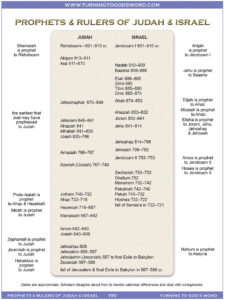 wave of the Babylonian Captivity in 587–586 BC. Volume II: Restoration & Redemption continues with a survey of the post-exilic prophets, and includes an overview of the history between the end of the Babylonian Exile and the time of Jesus as well as a look at the major apocalyptic writings in the Old and New Testaments.
wave of the Babylonian Captivity in 587–586 BC. Volume II: Restoration & Redemption continues with a survey of the post-exilic prophets, and includes an overview of the history between the end of the Babylonian Exile and the time of Jesus as well as a look at the major apocalyptic writings in the Old and New Testaments.
prophets, priests & kings
Both volumes of Thus Says the LORD: God Speaks Through His Servants the Prophets examine the biblical development of the office of prophet, and how and why the prophet’s role differs from the role of a king or a priest. The study examines the nature of the prophet’s intimate relationship with God and the way in which Jesus not only fulfills Old Testament prophecy but also speaks for God as the ultimate prophet. Finally, Thus Says the LORD: God Speaks Through His Servants the Prophets sheds light on how we as Christians can fulfill our own baptismal calling to share in Jesus’ prophetic mission, and on what God has revealed about our final destiny of heaven. Click on the chart (above) to enlarge it. The original chart appears twice in Thus Says the LORD: God Speaks Through His Servants the Prophets—on the back page in Volume I: A Kingdom Divided and on page 13 in Volume II: Restoration & Redemption.
map notes—setting the stage
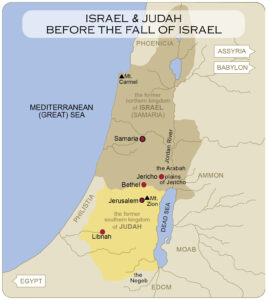 The land of Canaan promised to the descendants of Abraham, Isaac, and Jacob is part of a larger area sometimes referred to as the Fertile Crescent. River-based trade in the ancient Near East traced a route from the Nile River in Egypt northward along the coastline of the Mediterranean Sea before veering toward the Tigris and Euphrates Rivers in Mesopotamia (present-day Iraq). The descendants of Jacob occupied a narrow strip of land along the Dead Sea and Jordan River. Precariously situated in the middle of the trade routes linking Egypt and Mesopotamia, the area is roughly 150 miles long and 60 miles wide and is marked by diverse geography. In the central region, the altitude climbs to about 3,000 feet above sea level; 25 miles away, the Dead Sea registers 1,290 feet below sea level, the lowest place on the planet. The northern region around Galilee is hilly and fertile, while the Negeb (sometimes called the Negev) to the south of the Dead Sea is an arid wilderness terrain.
The land of Canaan promised to the descendants of Abraham, Isaac, and Jacob is part of a larger area sometimes referred to as the Fertile Crescent. River-based trade in the ancient Near East traced a route from the Nile River in Egypt northward along the coastline of the Mediterranean Sea before veering toward the Tigris and Euphrates Rivers in Mesopotamia (present-day Iraq). The descendants of Jacob occupied a narrow strip of land along the Dead Sea and Jordan River. Precariously situated in the middle of the trade routes linking Egypt and Mesopotamia, the area is roughly 150 miles long and 60 miles wide and is marked by diverse geography. In the central region, the altitude climbs to about 3,000 feet above sea level; 25 miles away, the Dead Sea registers 1,290 feet below sea level, the lowest place on the planet. The northern region around Galilee is hilly and fertile, while the Negeb (sometimes called the Negev) to the south of the Dead Sea is an arid wilderness terrain.
The first  volume in this Turning to God’s Word Catholic Bible study, Thus Says the LORD: God Speaks Through His Servants the Prophets—Volume I: A Kingdom Divided, addresses prophecy during the time that preceded the Babylonian Exile. Click on the map (above right) to enlarge it. The original map on page 10 in Thus Says the LORD: God Speaks Through His Servants the Prophets—Volume II: Restoration & Redemption.
volume in this Turning to God’s Word Catholic Bible study, Thus Says the LORD: God Speaks Through His Servants the Prophets—Volume I: A Kingdom Divided, addresses prophecy during the time that preceded the Babylonian Exile. Click on the map (above right) to enlarge it. The original map on page 10 in Thus Says the LORD: God Speaks Through His Servants the Prophets—Volume II: Restoration & Redemption.
After the death of Solomon, David’s united kingdom was torn into two parts. The southern kingdom of 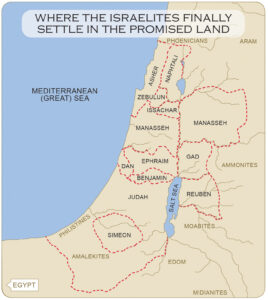 Judah encompassed territory settled by the tribes of Judah and Benjamin. The northern kingdom of Israel was made up of territory occupied by the remaining descendants of Jacob. These included the tribes of Reuben, Dan, Naphtali, Gad, Asher, Issachar, and Zebulun, and the two half-tribes of Ephraim and Manasseh, the Egyptian-born sons of Joseph. Because members of the tribe of Levi were consecrated to serve as priests and in other duties connected with worship, their descendants lived in both the northern and the southern kingdoms. Scholars believe that some members of the tribe of Simeon were absorbed by the tribe of Judah while others drifted north where they intermingled with other tribes and became part of the northern kingdom. When the Assyrians conquered Israel in 722–721 B.C, the inhabitants of the former northern kingdom were relocated and foreigners were brought in to resettle the area. When the southern kingdom of Judah fell in 587–586 B.C, most of the inhabitants of Judah were deported to Babylon. To
Judah encompassed territory settled by the tribes of Judah and Benjamin. The northern kingdom of Israel was made up of territory occupied by the remaining descendants of Jacob. These included the tribes of Reuben, Dan, Naphtali, Gad, Asher, Issachar, and Zebulun, and the two half-tribes of Ephraim and Manasseh, the Egyptian-born sons of Joseph. Because members of the tribe of Levi were consecrated to serve as priests and in other duties connected with worship, their descendants lived in both the northern and the southern kingdoms. Scholars believe that some members of the tribe of Simeon were absorbed by the tribe of Judah while others drifted north where they intermingled with other tribes and became part of the northern kingdom. When the Assyrians conquered Israel in 722–721 B.C, the inhabitants of the former northern kingdom were relocated and foreigners were brought in to resettle the area. When the southern kingdom of Judah fell in 587–586 B.C, most of the inhabitants of Judah were deported to Babylon. To  see where each of the 12 tribes originally settled when they first arrived in the land of Canaan, click on the second map (right) to enlarge it. The original map accompanies Lesson 28 Jacob’s Final Words to His Sons in the Turning to God’s Word Catholic Bible study In the Beginning: The Book of Genesis.
see where each of the 12 tribes originally settled when they first arrived in the land of Canaan, click on the second map (right) to enlarge it. The original map accompanies Lesson 28 Jacob’s Final Words to His Sons in the Turning to God’s Word Catholic Bible study In the Beginning: The Book of Genesis.
 a Bible study that’s relevant right this minute (01:24:05)
a Bible study that’s relevant right this minute (01:24:05)
In the video for Lesson One, Turning to God’s Word author Matthew Phelps recaps  what was going on in the Holy Land at the end of Volume I: A Kingdom Divided, and he provides a roadmap of where Volume II: Restoration & Redemption of this study is headed. Themes from the Old Testament prophets that are relevant to present-day Christians include: 1) mortal sin always comes at a cost; 2) there’s no such thing as partial truth; 3) the end never justifies the means—and thinking it does flies in the face of faith in God; 4) to get the graces associated with serving God you actually have to
what was going on in the Holy Land at the end of Volume I: A Kingdom Divided, and he provides a roadmap of where Volume II: Restoration & Redemption of this study is headed. Themes from the Old Testament prophets that are relevant to present-day Christians include: 1) mortal sin always comes at a cost; 2) there’s no such thing as partial truth; 3) the end never justifies the means—and thinking it does flies in the face of faith in God; 4) to get the graces associated with serving God you actually have to  serve God; 5) holiness is a separation from what people consider to be normal; 6) flawed humans routinely abuse power; 7) the prophets help us repent because they help us rethink our actions.
serve God; 5) holiness is a separation from what people consider to be normal; 6) flawed humans routinely abuse power; 7) the prophets help us repent because they help us rethink our actions.
The Scripture ranges for the videos that accompany this Catholic Bible study match the ranges for the sets of questions in Thus Says the LORD: God Speaks Through His Servants the Prophets—Volume II: Restoration & Redemption. You can follow along as Turning to God’s Word author Matthew Phelps discusses Lesson 1, “How the Divided Kingdom Came to an End,” on pages 4–13 in the study book.
although this is labeled as a Bible study, no one is getting graded
Lessons are the easiest way to talk about how the study is divided, but Thus Says the LORD: God Speaks Through His Servants the Prophets isn’t academic. Turning to God’s Word Catholic Bible studies are more than intellectual exercises. Accept that God is guiding the process. As long as you’re doing what you can manage and are sincere, it doesn’t matter how much or how little you do, or whether you get the same things out of Bible study that someone else does. God will speak to you where you are.
WHAT DO YOU THINK about history & theology?
It’s easy for Christians to assume that both kingdoms fell for political and military reasons. For the descendants of Jacob, however, the fall of the southern kingdom triggered an intense spiritual crisis. At the center were doubts about what the people always had considered to be their special covenant relationship with God. Impossible, unthinkable things had happened to call that into question. The kingdom of Judah had been conquered—despite the LORD’s promise in the Second Book of Samuel 7:16 that David’s kingdom would be established through his descendants forever. In addition, the LORD had allowed the Temple in Jerusalem, his earthly dwelling, to be destroyed. Finally, most of the descendants of the very people God had delivered from slavery in Egypt and had given an inheritance in the land of Canaan now were deported from the southern kingdom, following the earlier deportation in 722–721 B.C. of many of those living in the  northern kingdom. The Turning to God’s Word Catholic Bible study The United Kingdom of Israel: Saul, David & Solomon Foreshadow Christ the King looks closely at how David’s kingdom is related to present-day Christianity.
northern kingdom. The Turning to God’s Word Catholic Bible study The United Kingdom of Israel: Saul, David & Solomon Foreshadow Christ the King looks closely at how David’s kingdom is related to present-day Christianity.
 ? Read the seventeenth chapter in the Second Book of the Kings. What reasons are given for why the LORD allowed the people of the northern kingdom of Israel to be defeated by the Assyrians?
? Read the seventeenth chapter in the Second Book of the Kings. What reasons are given for why the LORD allowed the people of the northern kingdom of Israel to be defeated by the Assyrians?
? What reasons are given for why the LORD allowed the people of the southern kingdom of Judah to be defeated by the Babylonians?
? Whom did God send to warn the people about these disasters before they happened?
? What might explain why the kings in the north and the south failed to listen to the prophets sent by God?
? Consider what is the people’s greatest sin against the LORD.
? What might be the greatest sin against the LORD committed by people in the present day?
? What is God doing to encourage people in our world to turn away from sin?
? Why might people today choose not to be concerned about the inevitability of divine judgment?
? What does this suggest about the role of theology in the present-day world?
covenant—you could look it up in our archives
The prophets are consistent in identifying sin at the  heart of the spiritual crises faced by the descendants of Jacob. Throughout the Old Testament, sin is described as a failure of the people to live up to their covenant with God. To learn about “covenant,” read Lost in Translation, an online column in which Turning to God’s Word author Matthew Phelps helps readers connect with ideas expressed in the original languages of the Scriptures. New Lost in Translation entries are posted on Mondays, and past entries are archived on our website. Contact us if you’d like to receive Lost in Translation by email every week.
heart of the spiritual crises faced by the descendants of Jacob. Throughout the Old Testament, sin is described as a failure of the people to live up to their covenant with God. To learn about “covenant,” read Lost in Translation, an online column in which Turning to God’s Word author Matthew Phelps helps readers connect with ideas expressed in the original languages of the Scriptures. New Lost in Translation entries are posted on Mondays, and past entries are archived on our website. Contact us if you’d like to receive Lost in Translation by email every week.
why should we care about Old Testament prophets?
The prophets point the way to Jesus. Christians can learn much by becoming familiar with the prophets’ lives and prophecies recorded in the Old Testament. The mathematician and Catholic theologian Blaise Pascal, writing in the 1600s, made this comment:
“If a single man had written a book foretelling the time and manner of Jesus’ coming and Jesus had come in conformity with these prophecies, this would carry infinite weight—but there is much more here. There is a succession of men over a period of 4,000 years, coming consistently and invariably one after the other, to foretell the same coming. This is of quite a different order of importance.”
read the Catechism—how does the Church view the Old Testament?
Paragraphs 122 and 123 in the Catechism of the Catholic Church explain why it is that Christians should become familiar with the Old Testament.
 122 Indeed, “the economy of the Old Testament was deliberately so oriented that it should prepare for and declare in prophecy the coming of Christ, redeemer of all men.” “Even though they contain matters imperfect and provisional,” the books of the Old Testament bear witness to the whole divine pedagogy of God’s saving love: these writings “are a storehouse of sublime teaching on God and of sound wisdom on human life, as well as a wonderful treasury of prayers; in them, too, the mystery of our salvation is present in a hidden way.”
122 Indeed, “the economy of the Old Testament was deliberately so oriented that it should prepare for and declare in prophecy the coming of Christ, redeemer of all men.” “Even though they contain matters imperfect and provisional,” the books of the Old Testament bear witness to the whole divine pedagogy of God’s saving love: these writings “are a storehouse of sublime teaching on God and of sound wisdom on human life, as well as a wonderful treasury of prayers; in them, too, the mystery of our salvation is present in a hidden way.”
123 Christians venerate the Old Testament as true Word of God. The Church has always vigorously opposed the idea of rejecting the Old Testament under the pretext that the New has rendered it void (Marcionism).
what is Marcionism?
This heresy, named after a ship owner called Marcion, began in Rome around the middle of the 2nd century A.D. Although Marcion accepted Jesus as Savior of the world, he rejected that the God of the New Testament was the same as the God revealed in the Old Testament, whom he saw as the author of evil and lesser than the God revealed by Jesus. Several early Christian apologists of the time criticize Marcionism, including St. Justin Martyr, St. Irenaeus of Lyons, and St. Hippolytus.
who are the Chaldeans?
Mentioned in the twenty-fifth chapter in the Second Book of the Kings, the Chaldeans were a nomadic people who eventually became absorbed by the Babylonians. In the present day, Chaldean Christians are a small group of Catholic Christians who originated in the area of Iraq once known as Assyria and then as Babylon. Originally part of the Eastern Church, which split with Rome over the teachings of Nestorius at the Council of Ephesus in 431 A.D., Chaldean Christians came into full communion with the Catholic Church in 1552 A.D. They are located mostly in northern Iraq, southeastern Turkey, and northeastern Syria, economically poor areas where they suffer religious and ethnic persecution.
how is this relevant?
It’s easy to get absorbed in the geopolitical history of what’s happening after the Babylonian Exile and miss thinking about ways in which the biblical text relates to our present-day world. Commentaries in the study book Thus Says the LORD: God Speaks Through His Servants the Prophets—Volume II: Restoration & Redemption are designed to make it easier to reflect on ways that God’s Word applies to Christians. Additional reflection questions can be found on these online study pages and posed by the free videos that accompany each lesson.
 ? Read “You Shall Have No Other Gods” on page 9 in Thus Says the LORD: God Speaks Through His Servants the Prophets—Volume II: Restoration & Redemption. What’s the foundation of the covenant between God and the descendants of Jacob?
? Read “You Shall Have No Other Gods” on page 9 in Thus Says the LORD: God Speaks Through His Servants the Prophets—Volume II: Restoration & Redemption. What’s the foundation of the covenant between God and the descendants of Jacob?
? What’s the foundation of the New Covenant between God and humanity instituted by Jesus Christ?
? How are these two covenants similar?
? What forms of idolatry threaten Christians? (Hint: None probably involve carved idols.)
? What aids does the Church provide to help Christians remain faithful to Jesus’ New Covenant?
? What other Christian connections in the biblical texts underlie Lesson 1?
what’s going on in the world of the prophets?
It only makes sense to look at the prophets in terms of their place in history as well as their individual audiences, but it can be challenging to keep track of this geopolitical information, much of which doesn’t appear in Scripture. Lessons in Thus Says the LORD: God Speaks Through His Servants the Prophets—Volume II: Restoration & Redemption include brief commentaries labeled “Geopolitics” designed to make it easier to follow what’s happening in the Middle East during the time of the Babylonian Exile and after the Return.
what do the names Mattaniah & Zedekiah mean? our glossary can tell you
Entering the world of the Old Testament can be disconcerting because we’re not acquainted with the  people who populate that time, and many of the places mentioned in the Scriptures no longer exist. It’s no small task to keep track of the large number of relatively unfamiliar names. To learn more about the people and places that appear in this study of the prophets, visit our online glossary, which also includes the meaning of many of the names in the biblical text. The name Mattaniah, for instance, is a variation of the name Matthew, which means “gift of God.” When Nebuchadnezzar, king of Babylon, made Jehoiachin’s uncle Mattaniah a figurehead ruler in the southern kingdom of Judah in 597 B.C., he changed Mattaniah’s name to Zedekiah, which means “justice of God.” What point do you think that Nebuchadnezzar was trying to make?
people who populate that time, and many of the places mentioned in the Scriptures no longer exist. It’s no small task to keep track of the large number of relatively unfamiliar names. To learn more about the people and places that appear in this study of the prophets, visit our online glossary, which also includes the meaning of many of the names in the biblical text. The name Mattaniah, for instance, is a variation of the name Matthew, which means “gift of God.” When Nebuchadnezzar, king of Babylon, made Jehoiachin’s uncle Mattaniah a figurehead ruler in the southern kingdom of Judah in 597 B.C., he changed Mattaniah’s name to Zedekiah, which means “justice of God.” What point do you think that Nebuchadnezzar was trying to make?
biblical vocabulary—fetters
The Second Book of the Kings 25:7 records that when Zedekiah, the last king to rule the southern kingdom prior to the Babylonian Exile, was captured by Nebuchadnezzar’s forces, he was placed in fetters. Fetters is not a word that’s heard very often in the common vernacular. It refers to chains or manacles that restrict a prisoner’s movements. Fetters usually are placed around a captive’s ankles.
ex libris—here’s helpful book you might like
For more information about the prophets, check out The Prophets by Jewish scholar Abraham Heschel. 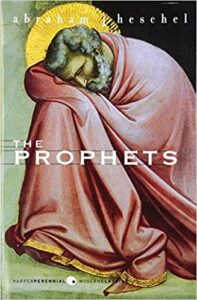 This book, which has influenced how
This book, which has influenced how  Christian scholars think about these Old Testament figures, is characterized by beautiful writing and insights based on the author’s intensely spiritual approach to the Hebrew Scriptures. Heschel’s grasp of who the prophets are sheds light on their original audience in ways that can deepen our Christian understanding about how all prophecy points toward Jesus, even though that isn’t a position held by the Jewish author. At ex libris—main bookshelf, read an excerpt and learn more about this and other books related to Bible study.
Christian scholars think about these Old Testament figures, is characterized by beautiful writing and insights based on the author’s intensely spiritual approach to the Hebrew Scriptures. Heschel’s grasp of who the prophets are sheds light on their original audience in ways that can deepen our Christian understanding about how all prophecy points toward Jesus, even though that isn’t a position held by the Jewish author. At ex libris—main bookshelf, read an excerpt and learn more about this and other books related to Bible study.
visual meditation as a form of prayer
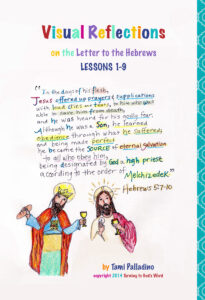 If you like to draw, consider illustrating your prayers for Thus Says the LORD: God Speaks Through His Servants the Prophets—Volume II: Restoration & Redemption.
If you like to draw, consider illustrating your prayers for Thus Says the LORD: God Speaks Through His Servants the Prophets—Volume II: Restoration & Redemption.  For inspiration, check out Turning to God’s Word co-founder Tami Palladino’s visual-meditation journal, created to accompany another of our Catholic Bible studies—The Letter to the Hebrews: An Explanation of the Mechanism of Our Salvation. Tami also illustrated Sing a New Psalm: Communicating with God Through the Prayers of the Church—Volume I: Lauds & Vespers and The Revelation of Jesus Christ: The Faithful Witness as well as some lessons in In the Beginning: The Book of Genesis and You Shall Have No Other Gods: The Book of Exodus.
For inspiration, check out Turning to God’s Word co-founder Tami Palladino’s visual-meditation journal, created to accompany another of our Catholic Bible studies—The Letter to the Hebrews: An Explanation of the Mechanism of Our Salvation. Tami also illustrated Sing a New Psalm: Communicating with God Through the Prayers of the Church—Volume I: Lauds & Vespers and The Revelation of Jesus Christ: The Faithful Witness as well as some lessons in In the Beginning: The Book of Genesis and You Shall Have No Other Gods: The Book of Exodus.
Q&A—what is the correct listing of the 12 tribes of Israel?
One participant in this study had a question about why Ephraim and Manasseh are referred to as half  tribes, and that led another participant to comment on something she remembered from our study of the book of Revelation about the listing of the tribes.
tribes, and that led another participant to comment on something she remembered from our study of the book of Revelation about the listing of the tribes.
Q: Why are Ephraim and Manasseh referred to as half tribes?
A: Ephraim and Manasseh are the two Egyptian-born sons of Joseph, the eleventh son of Jacob. At the end of the book of Genesis, Jacob adopts both boys, and they essentially split what otherwise would have been considered their father Joseph’s inheritance of land in Canaan. Scripture sometimes calls their descendants members of the tribes of Ephraim and Manasseh, but sometimes they are referred to as members of half tribes. Although listings of Jacob’s sons always include Joseph, there are very few instances in which Scripture  includes Joseph in the listing of the 12 tribes of Israel. The Turning to God’s Word Catholic Bible study In the Beginning: The Book of Genesis looks at the early history surrounding Jacob and his family.
includes Joseph in the listing of the 12 tribes of Israel. The Turning to God’s Word Catholic Bible study In the Beginning: The Book of Genesis looks at the early history surrounding Jacob and his family.
Q: Why are there so many variations in biblical listings of the 12 tribes? Doesn’t the book of Revelation omit Dan and another tribe because of the location of the worship centers set up in the northern kingdom by Jeroboam to compete with Jerusalem in the southern kingdom?
A: This is an astute observation. It appears that the authors of Scripture manipulated the names of the 12 tribes to suit whatever point they were trying to emphasize at the time. The following information is from “Every Tribe of the Sons of Israel,” commentary with Lesson 8 Salvation Belongs to Our God on page 44 in the Turning to God’s Word Catholic Bible  study The Revelation of Jesus Christ: The Faithful Witness. This will come up again in the final lesson of our study of the prophets when we look at the book of Revelation.
study The Revelation of Jesus Christ: The Faithful Witness. This will come up again in the final lesson of our study of the prophets when we look at the book of Revelation.
“There are several listings of the 12 sons or 12 tribes of Israel in the Scriptures, with slight differences. The birth order of the 12 sons can be found in the book of Genesis 29:31—30:24 and 35:16–18.
“The book of Genesis 48:3–5 describes Jacob’s adoption of Joseph’s two sons, Ephraim and Manasseh, and they share Joseph’s inheritance. Joseph almost never is referred to as a one of the 12 tribes of Israel, but his sons Ephraim and Manasseh are considered founders of the two half-tribes.
“Still later, in the book of Exodus 32:21–29, the Levites distinguish themselves in service to the Lord. As a result, in the book of Exodus 40:12–15, they are set apart to serve as priests. After this, Levites no longer are included in listings of the 12 tribes.
“The book of Numbers 35:1–8 records that they are provided for by the other tribes.
In the book of Revelation 7:5, Judah is listed first among the tribes of Israel, almost certainly because Jesus is of the tribe of Judah. In the book of Revelation 7:8, Joseph and Benjamin appear to be listed last because they are last in the birth order.
“Dan and Ephraim are omitted from that list in the book of Revelation. A clue as to why appears in the First Book of the Kings 12:28–30, which records that Jeroboam, ruler of the Northern Kingdom of Israel, set up golden idols in Dan and Bethel (a city in Ephraim territory). The tribes of Dan and Ephraim appear to be excluded because they engaged in idolatry and led others away from worship of God.”
Q&A—Jews outside of the Promised Land at the time of the Exile
Another participant had a question about whether there were descendants of Jacob living outside of Judah and Samaria prior to the fall of the northern kingdom of Israel in 722–721 B.C. and the final fall of  the southern kingdom of Israel in 587–586 B.C. The short answer is no, but read on to learn more about why.
the southern kingdom of Israel in 587–586 B.C. The short answer is no, but read on to learn more about why.
Q: At the time the Babylonian Exile begins, weren’t there other Jews living outside of the territory allotted to the descendants of Jacob in the land of Canaan?
A: The timing is essential. Judaism is something that we’ll see develop over the course of this study. At the time the two kingdoms fall, the religion of Judaism doesn’t exist. The descendants of Jacob worship—or fail to worship, as the case may be—the God of their Hebrew forefathers, the patriarchs Abraham, Isaac, and Jacob. Judaism is based on Hebrew religious practices, but we’re going to see it develop along some new lines during the Babylonian Exile. It takes its name from Judah because it’s the religion of the captives from Judah. Practitioners of Judaism are called Jews. Descendants of Judah in the tribe of Judah properly are called Judahites, and the term Jew is inappropriately used to refer to anyone prior to the Babylonian Exile since the religion of Judaism didn’t yet exist.
By the time of Jesus, there are indeed Jews scattered throughout the ancient world. Early in the Acts of the Apostles, we read that a bunch of them had traveled to Jerusalem for the feast of Pentecost, an Old Testament religious festival that in our day has become a Christian religious festival as well, although for different reasons.
The fall of both the northern and southern kingdoms precipitates changes that lead to the development of Judaism, and other geopolitical changes we’ll see in this study will lead to pockets of Jews living outside of Jerusalem and Judea. Jesus, for instance, was raised in a devout Jewish family. He was taken to Egypt for a short time after his birth, and then he grew up in Nazareth in Galilee (sometimes referred to as Galilee of the nations because of the large number of Gentiles living there). Part of what makes Thus Says the LORD: God Speaks Through His Servants the Prophets—Volume II: Restoration & Redemption so interesting is that it offers explanations for how and when all of this stuff happened to make the world the way it was at the time of Jesus. Pretty soon we’ll be able to start calling the descendants of Jacob who were exiled to Babylon Jews, but not quite yet. We have to see what’s the catalyst for the change in worship practices that lead to the development of Judaism, which begins while God’s people are in captivity.
Prior to the development of Judaism, there are no records of anyone outside the descendants of Jacob following the Hebrew worship practices upon which that religion ultimately is based.
another video—one that could change the way you approach the Bible (40:44)
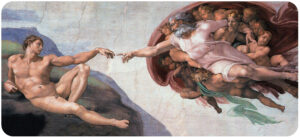 Even if you’re a veteran of Catholic Bible studies, we recommend that you watch an explanation of the practical benefits of approaching The Bible as the Living Word of God. This 40-minute video is distilled from a talk that Turning to God’s Word author Matthew Phelps gave at a summer Bible-study retreat at Conception Abbey in Conception, Missouri. In this video, Matthew looks at how viewing Scripture as a living document can help us to develop a more intimate relationship with Jesus Christ. There are real benefits in setting aside what we think we know about Scripture to approach the Bible with the goal of learning what new things God is saying to us. Matthew examines the principles of lectio divina, the traditional Catholic approach to reading and praying with Scripture that’s foundational for all Turning to God’s Word Bible studies.
Even if you’re a veteran of Catholic Bible studies, we recommend that you watch an explanation of the practical benefits of approaching The Bible as the Living Word of God. This 40-minute video is distilled from a talk that Turning to God’s Word author Matthew Phelps gave at a summer Bible-study retreat at Conception Abbey in Conception, Missouri. In this video, Matthew looks at how viewing Scripture as a living document can help us to develop a more intimate relationship with Jesus Christ. There are real benefits in setting aside what we think we know about Scripture to approach the Bible with the goal of learning what new things God is saying to us. Matthew examines the principles of lectio divina, the traditional Catholic approach to reading and praying with Scripture that’s foundational for all Turning to God’s Word Bible studies.
Q&A—where to find some answers
Some people who are used to doing Bible studies from other publishers miss the answer keys included in those studies. One leader even admitted to us that she relied on answer keys so she didn’t have to spend time doing Bible study lessons herself. We sympathize with omnipresent time constraints, but we maintain that up-front answer keys provide people with a strong temptation to rely on someone else’s idea of what Scripture means instead of thinking more deeply about what God might be trying to say to them personally at that moment.
 Q: Why don’t Turning to God’s Word Catholic Bible studies provide any printed answer keys?
Q: Why don’t Turning to God’s Word Catholic Bible studies provide any printed answer keys?
A: The Turning to God’s Word method of Bible study is dependent on participants directly engaging with the biblical text and looking to that text for answers to their questions. All of the factual questions in the lessons can be answered from the Scriptures. Sidebars in the lessons contain supplemental material written to help explain some of the themes suggested by the biblical text. Most of our studies, including this one, feature videos with each lesson.
Outside commentaries can shed light on individual texts, but many commentaries examine Scripture passages out of context. Some may focus on an academic rather than a spiritual approach to the Bible. If you’re confused about anything in our studies or in any related outside commentaries, we encourage you to browse our website for more information.
The goal of all Turning to God’s Word Catholic Bible studies is to foster personal reflection leading to a more intimate relationship with Jesus. Consequently, each lesson contains  reflection questions, and these necessarily don’t have any “right” or “wrong” answers. If you’d like to share your thoughts about any of our studies or need clarification about a question, commentary, or video related to the lessons, contact us using the “ask us your question” or “what do you think” button on any online lesson page. Because others may have the same concern, we routinely turn questions and comments we receive into anonymous Q&A items and add them to the relevant online study pages.
reflection questions, and these necessarily don’t have any “right” or “wrong” answers. If you’d like to share your thoughts about any of our studies or need clarification about a question, commentary, or video related to the lessons, contact us using the “ask us your question” or “what do you think” button on any online lesson page. Because others may have the same concern, we routinely turn questions and comments we receive into anonymous Q&A items and add them to the relevant online study pages.
Q&A—three questions about Bible translations
We’re frequently asked what translation of the Bible is best. Sometimes we’re asked which translation is approved to be read at Catholic Masses. More infrequently we’re asked why we’ve chosen to reprint the Revised Standard Version Second Catholic Edition (RSV2CE) for the biblical text in our printed studies.
Q1: Which translation of the Bible is the best one for Catholics to read? 
A2: As far as which translation is “best,” we maintain that reading any translation of the Bible you have on hand is a great place to start. The old adage “every translator is a traitor” certainly applies to Scripture, but God’s basic message to his people can be found in any Bible. While there are English-language Bibles catering to a variety of special-interest Catholic groups, they generally reprint either a translation of the New American Bible Revised Edition (the NABRE) or a Catholic edition of the Revised Standard Version (the RSVCE or the RSV2CE), which are the Bibles read by most American Catholics. Both of these translations rely on archeological finds and scholarship that were unavailable in earlier centuries. Prior to the mid-1960s, many Catholics were familiar with the Douay-Rheims English translation, which was based on the Latin Vulgate. Originally translated by St. Jerome in the late 4th century, a version of the Vulgate has remained the official Latin translation of the Catholic Church since the 16th century. Prior to the mid-1960s, most Protestants read The King James Version.
As people become more interested in Scripture study, they also become more interested in reading the “right” Bible. Since very few of us are proficient in ancient languages, we’re forced to rely on the work of scholars who’ve spent years studying Hebrew, Greek, Aramaic, and Latin. In many cases, there simply isn’t an easy way to translate some of the original words and phrases of Scripture into English. The best advice we can offer is to choose an English translation that the Church has approved. The United States Conference of Catholic  Bishops (USCCB) offers guidelines. When questions arise, as they undoubtedly will, check out footnotes, commentaries, and other translations; talk to a knowledgeable priest; and—this part is most important—ask God to grant you increased understanding. You also can email us with your questions about Scripture. In many cases, Turning to God’s Word author Matthew Phelps’ background in classical languages proves helpful. We frequently rely on him to shed some light on the linguistics involved in difficult passages
Bishops (USCCB) offers guidelines. When questions arise, as they undoubtedly will, check out footnotes, commentaries, and other translations; talk to a knowledgeable priest; and—this part is most important—ask God to grant you increased understanding. You also can email us with your questions about Scripture. In many cases, Turning to God’s Word author Matthew Phelps’ background in classical languages proves helpful. We frequently rely on him to shed some light on the linguistics involved in difficult passages
Q2: I’m having trouble locating the same Bible that I hear read at Mass. What translation is that?
A2: The Catholic Lectionary, a collection of biblical texts approved for liturgical use, isn’t the same as a Bible. The English-language lectionary used in the United States is primarily based on a 1970 translation. A close English translation outside the lectionary is the New American Bible Revised Edition (NABRE). The United States Conference of Catholic Bishops (USCCB) currently is working on a liturgical Bible based on the NABRE translation.
 Q3: Why has Turning to God’s Word chosen to reprint biblical text from the Revised Standard Version Second Catholic Edition (RSV2CE) instead of the New American Bible Revised Edition (NABRE)?
Q3: Why has Turning to God’s Word chosen to reprint biblical text from the Revised Standard Version Second Catholic Edition (RSV2CE) instead of the New American Bible Revised Edition (NABRE)?
A3: We currently use the Revised Standard Version Second Catholic Edition (RSV2CE) as our primary biblical translation in our printed studies because scholars consider it to be a more faithful word-for-word translation than many other translations. Pope Benedict XVI quotes from the RSV2CE in his three-volume book, Jesus of Nazareth. The RSVCE is the Bible translation used in English translations of the Catechism of the Catholic Church. The RSV2CE varies only slightly from the earlier RSVCE, which we link to on our online study pages. Any discrepancies between the RSV2CE and the RSVCE are pointed out on the online study pages. Turning to God’s Word cites The Abbey Psalms and Canticles in references to the Psalms in all of our printed studies.
pray with the Psalms—intensely emotional prayers
Although some scholars question David’s authorship of the Psalms, it remains indisputable that many of the Psalms address  themes related to events that occurred during the period when David ruled over the descendants of Jacob. Reading and praying with the Psalms offers insight into the minds and hearts of people who lived during the time of David—and long afterward as well. These prayers express universal human feelings every bit as relevant to us in the present day as when the Psalms first were composed.
themes related to events that occurred during the period when David ruled over the descendants of Jacob. Reading and praying with the Psalms offers insight into the minds and hearts of people who lived during the time of David—and long afterward as well. These prayers express universal human feelings every bit as relevant to us in the present day as when the Psalms first were composed.
don’t get confused—Psalms numbering varies
Numbering of many Psalms and their verses varies depending on translation. Parallel  numbering for commonly used Catholic Bibles is noted in the citations index in Thus Says the LORD: God Speaks Through His Servants the Prophets—Volume II: Restoration & Redemption and in the index included in the sample lesson. For more information about why the numbering varies, see the Q&A on the online study page for Lesson 1 Set a Guard on My Mouth in Sing a New Psalm: Communicating with God Through the Prayers of the Church—Volume I: Lauds & Vespers.
numbering for commonly used Catholic Bibles is noted in the citations index in Thus Says the LORD: God Speaks Through His Servants the Prophets—Volume II: Restoration & Redemption and in the index included in the sample lesson. For more information about why the numbering varies, see the Q&A on the online study page for Lesson 1 Set a Guard on My Mouth in Sing a New Psalm: Communicating with God Through the Prayers of the Church—Volume I: Lauds & Vespers.
 the best Catholic commentary about Scripture
the best Catholic commentary about Scripture
To find out more about how Church teaching is supported by Scripture passages in Thus Says the LORD: God Speaks Through His Servants the Prophets—Volume II: Restoration & Redemption, check out the Index of Citations in the Catechism of the Catholic Church. Links (Revised Standard Version Catholic Edition [RSVCE*]) to the primary Scripture passages in the lesson and relevant paragraphs in the Catechism are provided here. Not every passage in the biblical text for this Catholic Bible study is referenced in a Catechism paragraph, however, including the following passages from this lesson: the Second Book of the Kings 17:1–41, the Second Book of the Kings 24:8—25:15, and the Second Book of the Kings 25:18–21.
ways our glossary might prove helpful
In addition to providing extra information about geographical locations, our glossary also points out  persons and places mentioned in the biblical text under multiple names or spellings. If you can remember a name but aren’t sure in which lesson it shows up, you can find it in the glossary, which lists every proper noun that appears in the primary biblical text for Thus Says the LORD: God Speaks Through His Servants the Prophets—Volume II: Restoration & Redemption.
persons and places mentioned in the biblical text under multiple names or spellings. If you can remember a name but aren’t sure in which lesson it shows up, you can find it in the glossary, which lists every proper noun that appears in the primary biblical text for Thus Says the LORD: God Speaks Through His Servants the Prophets—Volume II: Restoration & Redemption.
to learn more, read more Scripture
It can help to check out the cross references listed in Scripture, but looking them up is time-consuming. To make that part easier, we’ve  compiled the cross references from the Revised Standard Version Second Catholic Edition (RSV2CE)—the translation that we reprint in our study books. That list can be found at the top of every online study page accompanying this study, and it includes links to each of the cross references in the primary biblical text for Thus Says the LORD: God Speaks Through His Servants the Prophets—Volume II: Restoration & Redemption.
compiled the cross references from the Revised Standard Version Second Catholic Edition (RSV2CE)—the translation that we reprint in our study books. That list can be found at the top of every online study page accompanying this study, and it includes links to each of the cross references in the primary biblical text for Thus Says the LORD: God Speaks Through His Servants the Prophets—Volume II: Restoration & Redemption.
don’t forget about our indexes & extra online material

 If you’re trying to locate information about a specific Scripture passage, you can look it up in the index at the back of the study book or sample lesson. If you want to find a particular commentary, you can look up its title in the topics index. To learn more about another book of the Bible for which there’s a Turning to God’s Word study, visit the online study directories to read the commentaries and watch any accompanying videos. Finally, if you have a question or would like to make a comment about any of our studies, you can use one of the “ask us your question” or “what do you think” buttons to email our authors.
If you’re trying to locate information about a specific Scripture passage, you can look it up in the index at the back of the study book or sample lesson. If you want to find a particular commentary, you can look up its title in the topics index. To learn more about another book of the Bible for which there’s a Turning to God’s Word study, visit the online study directories to read the commentaries and watch any accompanying videos. Finally, if you have a question or would like to make a comment about any of our studies, you can use one of the “ask us your question” or “what do you think” buttons to email our authors.
ex libris—Church documents & books about religious topics
Link to magisterial documents referred to in our Bible studies at ex libris—magisterial documents.  This listing includes significant recent encyclicals as well as a number of historical Church documents. Recommended books related to Scripture study can be found at ex libris—main bookshelf.
This listing includes significant recent encyclicals as well as a number of historical Church documents. Recommended books related to Scripture study can be found at ex libris—main bookshelf.
memorize a favorite Bible verse (4:46)
Tami Palladino has created a short video about the benefits of memorizing Bible verses. Choosing a passage that you find particularly meaningful will make the task easier. There are inspiring verses in every book of the Bible, but some people in our Turning to God’s Word Catholic Bible studies like to memorize a verse from their lesson every week. For more ideas, check out Tami’s video, Why Memorize Scripture? It’s less than five minutes long.
wondering how to pronounce some of these words?
The following links are to readings from the New International Version (NIV) Bible. To listen, open one of the links and click on the audio icon above the printed text. Although not taken from the translations used in our study materials, the NIV readings provide an audio guide to pronunciation of words in this lesson’s primary biblical texts. A close online version of the translation of the Bible used in Catholic liturgy in the United States as well as an audio guide for daily Mass readings for the current month can be found on the website of the United States Conference of Catholic Bishops (USCCB).
the Second Book of the Kings 17:1–41 (NIV)
the Second Book of the Kings 24:8–20 (NIV)
the Second Book of the Kings 25:1–21 (NIV)
 close with Bible-based prayer related to this lesson
close with Bible-based prayer related to this lesson
Many of our Catholic study groups like to conclude their discussions with a prayer based on the scriptural focus of their lesson, and some participants include Scripture-specific prayer in their individual study. If you’re uncomfortable composing your own Bible-based prayers you can follow our four easy steps, or you can use the following prayer based on this lesson’s biblical texts.
O God, throughout the ages you sent a number of prophets
to instruct and guide your people
before you sent your Son as your final and definitive Word.
Give us the faith, hope, and love to listen to your Word today
and to accept your will even in difficult situations.
We ask this in the name of Jesus Christ,
who leads his imperfect Church along the path of righteousness
toward the ultimate perfection of heaven. Amen.
Lesson 2 Jeremiah After the Fall of Jerusalem—the Second Book of the Kings 25:22–26, the Book of Jeremiah 15:15–21, the Book of Jeremiah 18:18–23, the Book of Jeremiah 20:7–13, the Book of Jeremiah 29:10–13, the Book of Jeremiah 31:31–34, the Book of Jeremiah 32:1–8, and the Book of Jeremiah 32:36–41
you also may like Volume I of our prophets study
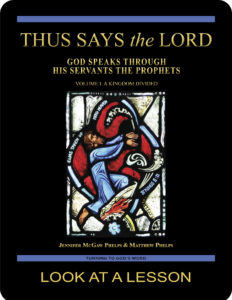 Thus Says the LORD: God Speaks Through His Servants the Prophets—Volume I: A Kingdom Divided examines the prophets in their historical context based on the First and Second Books of the Kings and writings of biblical prophets before the Babylonian Exile in 586 B.C. It builds on The United Kingdom of Israel: Saul, David & Solomon Foreshadow Christ the King, an in-depth look at the kingdoms ruled by Saul, David, and Solomon—with special emphasis on David as a type of Jesus. Click on the book’s cover to view a sample lesson.
Thus Says the LORD: God Speaks Through His Servants the Prophets—Volume I: A Kingdom Divided examines the prophets in their historical context based on the First and Second Books of the Kings and writings of biblical prophets before the Babylonian Exile in 586 B.C. It builds on The United Kingdom of Israel: Saul, David & Solomon Foreshadow Christ the King, an in-depth look at the kingdoms ruled by Saul, David, and Solomon—with special emphasis on David as a type of Jesus. Click on the book’s cover to view a sample lesson.
start a Turning to God’s Word Bible study
Thank you for your interest in Thus Says the LORD: God Speaks Through His Servants the Prophets— Volume II: Restoration & Redemption. You can find information
Volume II: Restoration & Redemption. You can find information  on this website about beginning a Turning to God’s Word Bible study at start a Bible study. Tami, Matthew, and I are available to answer your questions and address any of your concerns. Contact us if you’d like to start one of our studies or have your schedule listed with other TtGW study groups on our website. —Jennifer
on this website about beginning a Turning to God’s Word Bible study at start a Bible study. Tami, Matthew, and I are available to answer your questions and address any of your concerns. Contact us if you’d like to start one of our studies or have your schedule listed with other TtGW study groups on our website. —Jennifer
*There are seven deuterocanonical books in the Old Testament—the Books of Tobit, Judith, Wisdom, Sirach, Baruch, and First and Second Maccabees, as well as some passages in the Books of Esther and Daniel. Protestants usually refer to these works as “apocryphal,” a word that means “outside the (Protestant) canon” because they’re excluded from most Protestant Bibles. The word “deuterocanonical” means “second canon”; Catholics use that word to refer to any section of the Catholic Old Testament for which there are no extant, or existing, Hebrew manuscripts. All of the deuterocanonical books appear in the Septuagint, the earliest remaining versions of which date to the 1st century B.C. This Greek translation of the Old Testament was in common use by Jews at the time of Jesus—but the same books aren’t found in existing Hebrew manuscripts, which aren’t as old as the oldest version of the Septuagint. Learn more by reading How Do Catholic & Protestant Bibles Differ?
Turning to God’s Word printed Bible studies use the 2006 Revised Standard Version Second Catholic Edition (RSV2CE) translation for all Scripture references except those to the Psalms, which are taken from The Abbey Psalms and Canticles, prepared by the Benedictine monks of Conception Abbey and published in 2020 by the United States Conference of Catholic Bishops (USCCB). Scripture on the online study pages for Thus Says the LORD: God Speaks Through His Servants the Prophets—Volume II: Restoration & Redemption links to the 1966 Revised Standard Version Catholic Edition (RSVCE). The New International Version (NIV) audio recordings follow the same chapter and verse numbering as the RSV Catholic translations, but the NIV doesn’t include the deuterocanonical books and passages.
The 1966 RSVCE uses archaic pronouns and verb forms such as “thee,” “thou,” “didst” in the Psalms and in direct quotations attributed to God. The 2006 RSV2CE replaces those with more accessible English. The few significant translation changes in the RSV2CE include rendering almah as “virgin” in the Book of Isaiah 7:14 and restoring the term “begotten” in the Gospel According to John 3:16.
Numbering varies for some passages in this Bible study. Turning to God’s Word studies (print and digital) follow the numbering in the Revised Standard Version Catholic translations (RSV2CE and RSVCE). Discrepancies in the New American Bible Revised Edition (NABRE) are noted in the Index of Scripture Citations in the study book and the online sample.
 You can learn more about the Psalms by viewing a sample lesson from the Turning to God’s Word Catholic Bible study Sing a New Psalm: Communicating with God Through the Prayers of the Church—Volume I: Lauds & Vespers. The second part of that study, Sing a New Psalm: Communicating with God Through the Prayers of the Church—Volume II: Vigils, Day Prayer & Compline, is scheduled for publication in 2025. Some verse numbers may vary in different translations of the Psalms.
You can learn more about the Psalms by viewing a sample lesson from the Turning to God’s Word Catholic Bible study Sing a New Psalm: Communicating with God Through the Prayers of the Church—Volume I: Lauds & Vespers. The second part of that study, Sing a New Psalm: Communicating with God Through the Prayers of the Church—Volume II: Vigils, Day Prayer & Compline, is scheduled for publication in 2025. Some verse numbers may vary in different translations of the Psalms.
**The Book of Isaiah 55:10-11 (RSV2CE) reads: “For as the rain and the snow come down from heaven,
and do not return there but water the earth, making it bring forth and sprout, giving seed to the sower and bread to the eater, so shall my word be that goes forth from my mouth; it shall not return to me empty, but it shall accomplish that which I intend, and prosper in the thing for which I sent it.”
